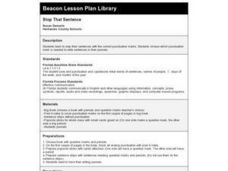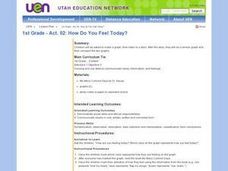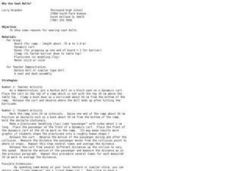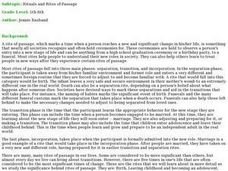Great Books Foundation
On the Origin of Species
How did Charles Darwin support his controversial theory of evolution with evidence? Use an excerpt from his 1859 work On the Origin of Species to reinforce the importance of making inferences within an informational text, and to discuss...
Curated OER
Comparison Shopping
Young scholars practice developing budgets. In this financial awareness lesson, students read The Monster Money Book and list ways the characters saved money in the story. Young scholars plan a budget and demonstrate how to look for...
Curated OER
Developing Respect
Students develop an understanding of how being caring and respectful affects their relationship with people around them. They discuss responsibility, choices and consequences for behavior. Students read and discuss stories on being...
Curated OER
How To Use the Internet To Make Student Glossaries
Students use an internet dictionary to produce a glossary of words related to a particular subject area being studied. They choose the correct meaning of the word for their glossary, based on it's relationship to the subject matter being...
Curated OER
Twas the Day Before Zoo Day
In this zoo math worksheet, students read and solve 10 word problems pertaining to the zoo. Students mark the correct answer from 4 choices. This is related to a literature book called Twas the Day Before Zoo Day.
Curated OER
On Your Mark, Get Set, GO!
Students in order to become a fluent reader need to read often and repeat what they read over and over. Repeated reading helps students gain better knowledge of text. Fluent readers recognize words automatically and with this automatic...
Curated OER
New York State Testing Program English Language Arts Book 1--Grade 7 (2006)
In this New York State Testing Program English Language Arts worksheet, students read several passages and two poems and answer reading comprehension questions. Students then write an essay response to one of the passages.
Curated OER
The Wolf in Children's Books: Part 2 of 2
Third graders gather information about wolves and compare it to information presented or inferred in studenT stories they read in Part 1
Curated OER
Introduction and Making Textured Beads
Students explore the basics of working with polymer clay. They experiment with textures, inclusions. Students explore adding sand or glitter to their inclusions. Students create textured beads from the clay.
Curated OER
On Your Mark, Get Set, Read
Students increase their reading fluency through the use of various strategies. After reviewing chunking, decoding, and rereading, students complete an initial read of a novel text. Working with the instructor, they read complete a timed...
Curated OER
On Your Mark, Get Set, Read
Students improve their reading fluency through the use of various strategies. After reviewing decoding and rereading strategies, students work with the instructor to complete a timed assessment of their words read per minute.
Curated OER
STOP THAT SENTENCE
Students stop their sentences with the correct punctuation marks. They choose which punctuation mark is needed to write sentences in their journals.
Curated OER
American Expression
Students exercise the strategy of reading more fluently with expression through practice and recognizing punctuation marks when reading. They read with expression the book, Guess How Much I Love You by Sam McBratney and a variety of...
Curated OER
ESL: Vocabulary for University Students
In this ESL vocabulary for university students worksheet, students complete multiple choice questions that use "university" vocabulary. Students may click on an answer button for immediate feedback.
Curated OER
How Do You Feel Today?
Students create a graph, then listen to Dr. Seuss' book, My Many Colored Days. After the story, they do a similar graph and then compare the two graphs.
Curated OER
Go Ahead--Say What You Feel!
Young scholars observe and demonstrate a variety of strategies for reading with expression. They listen to the teacher read sentences with and without expression and discuss the type of punctuation that is needed. Students then listen...
Curated OER
Everybody Wears Braids
Students use picture clues, patterned sentences, number words and gain knowledge of what sentences that end with a question mark look like after reading, "Everybody Wears Braids." They connect the title to their lives and make a...
Curated OER
Op Art Circles
High schoolers create Optical Art, art that seems to move when you look at it, in this Art instructional activity for the High School classroom. Included with the instructional activity is a list of recommended materials and suggested...
Curated OER
Why Use Seat Belts?
Students explore reasons why using a seat belt is a safe choice while riding in a car. In this physics/safety instructional activity, students set up and observe a doll with and without a seat belt moving down a ramp in a dynamics cart....
Curated OER
Name Fame
First graders learn the uniqueness of their names by reading the book, Chrysanthemum, and completing other integrated math counting and graphing activities.
Curated OER
Rituals and Rites of Passage
Young scholars explore the concept of rites of passage and the rituals that society performs to mark certain moments in life. They read books, discuss the cultural implications of certain rites of passage, design a mural of funeral...
Curated OER
Seasons
Students explore the four seasons. In this seasons lesson, students create a class tree. Students make leaves for the tree for each of the seasons. Students mark their paper into fourths and draw a picture of the seasons.
Curated OER
GALIMOTO
Second graders identify Malawi, Africa on a map of Africa and demonstrate their resourcefulness and creativity by making their own galimoto.
Curated OER
Money Matters
In this money matters worksheet, students match the pictures of the coins to appropriate piggy banks mark with money amounts.

























